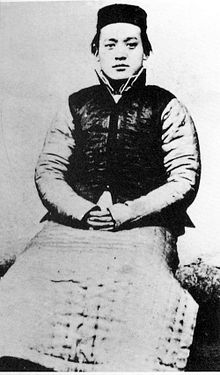Peng Chufan

Peng Chufan ( Chinese 彭楚藩 , Pinyin Péng Chǔfān ; * 1884 in today's Echeng district ; † October 10, 1911 in Wuchang ) was a Chinese soldier and revolutionary who was involved in the preparation of the Wuchang uprising . In 1906 he joined the New Army and was a soldier in the 11th platoon of the 21st Engineer and Transport Battalion. There he also entered the military academy, at the same time he became a member of a revolutionary organization called Rizhihui , where he devoted himself to the cultivation of a unified ideology.
A short time later he joined the Literary Society and the Society for Common Progress , where he was appointed representative of the Military Police Battalion and helped negotiate a joint plan for an uprising. In September 1911, the two companies formed a joint command of the Hubei revolutionary army and appointed Peng Chufan as the coordinator for military affairs. His job was to communicate and prepare for the Wuchang uprising. On September 24th he was appointed deputy head of the investigative authority of the military government after the successful uprising.
The uprising, planned for early October, was postponed several times because the governor general had imposed martial law on the city. Around noon on October 9, a bomb workshop exploded in a hiding place of the Society for Common Progress in Hankou, exposing the insurgents' plans. Peng Chufan was arrested by Chinese police that same day. Liu Fuji, together with the early morning of October 10, Liu Fuji and Yang Hongsheng before the east gate of the Yamen of the governor general of Huguang executed.
Rumors circulating following the execution of the arrested revolutionaries led the soldiers to start the uprising, originally planned for October 9th. The revolutionaries were in the minority in the New Army, but the rumors of the arbitrary executions of men without braids led many non-revolutionary soldiers to join the uprising because they saw it as the safer choice.
Individual evidence
- ↑ a b 辛亥 人物> 彭楚藩.辛亥革命 网, August 14, 2014, accessed on January 15, 2019 .
- ↑ Joseph W. Esherick: reform and revolution in China - the 1911 Revolution in Hunan and Hubei . 2nd Edition. Center for Chinese Studies, University of Michigan, Ann Arbor 1998, ISBN 0-89264-130-4 , pp. 179 .
- ↑ Dieter Kuhn: The Republic of China from 1912 to 1937 - Draft for a political history of events . 3. Edition. Edition Forum, Heidelberg 2007, ISBN 3-927943-25-8 , p. 80 .
- ↑ Joseph W. Esherick: reform and revolution in China - the 1911 Revolution in Hunan and Hubei . 2nd Edition. Center for Chinese Studies, University of Michigan, Ann Arbor 1998, ISBN 0-89264-130-4 , pp. 180 .
| personal data | |
|---|---|
| SURNAME | Peng Chufan |
| ALTERNATIVE NAMES | 劉 復 基; Péng Chǔfān |
| BRIEF DESCRIPTION | Chinese soldier and revolutionary |
| DATE OF BIRTH | 1884 |
| PLACE OF BIRTH | Echeng |
| DATE OF DEATH | October 10, 1911 |
| Place of death | Wuchang |
